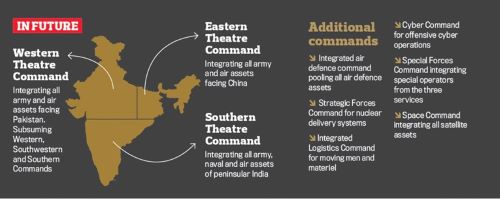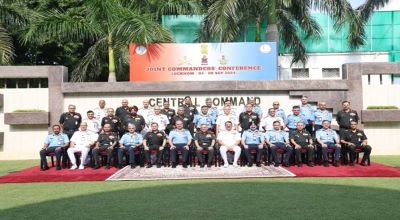Context-
The recent Joint Commanders Conference (JCC) held in Lucknow on September 4-5, 2024, saw the formulation of a comprehensive blueprint for the proposed Integrated Theatre Commands (ITC) by the Indian Armed Forces. This blueprint has been presented to the Raksha Mantri (RM) for further consideration. The discussions focused on the future capability development of the armed forces to address emerging geopolitical and technological challenges through joint and integrated responses.
Integration and Theaterisation: Key Concepts and Distinctions
The integration and theaterisation of the armed forces are significant politico-military endeavours aimed at transforming India's national security landscape. These efforts will help the country effectively tackle a broad spectrum of conflicts by enabling multi-domain operations that blend emerging technologies with conventional warfighting in an India-specific context. The plan envisions raising three ITCs:
1. Northern Theatre Command: China-specific, with headquarters at Lucknow.
2. Western Theatre Command: Pakistan-centric, with headquarters at Jaipur.
3. Maritime Theatre Command: Focused on the Indian Ocean, with headquarters at Thiruvananthapuram.

A notable recommendation is that all three theatre commanders, along with the Vice Chief of Defence Staff (VCDS)—a newly proposed appointment—be elevated to four-star Generals, on par with the Service Chiefs and the Chief of Defence Staff (CDS). This recommendation reflects the significant operational responsibilities these roles entail.
Defining Jointness, Integration, and Theatralisation
There is an overlapping use of the terms Jointness and Integration, and it is crucial to understand their nuanced distinctions:
- Jointness is rooted in mutual understanding and trust among services, fostering a cohesive culture beyond the individual identities of the Army, Navy, and Air Force. It involves coordinated planning, operations, communications, training, capability development, and acquisitions, while maintaining the distinct identities and command structures of each service.
- Integration, however, involves a deeper organizational restructuring where individual service identities merge to form a cohesive command structure. Resources from all services, including specialized commands like Space, Cyber, and Special Operations, are combined under a single commander to execute assigned tasks, thereby optimizing operational and logistical capabilities.
- Theaterisation assigns a geographical area of responsibility to an integrated, tri-service plus formation under a designated commander. This formation should ideally be self-sufficient in terms of operational and logistical resources, with the ability to secure its hinterland. The theaterisation process includes creating an integrated theatre plan and assigning missions and command responsibilities accordingly.
A critical aspect is that the road to theaterisation runs through integration. While integration is an urgent and non-negotiable necessity, theaterisation should be approached progressively, driven by the goal of enhancing operational efficiency and optimal resource utilization rather than merely reducing the number of commands.
Strategic Guidance and Planning for Theatre Commands
- There is broad consensus on establishing ITCs for the Northern, Western, and maritime theatres, but their specific compositions, resource allocations, and organizational structures require further deliberation. Clear strategic guidance and military strategies must be developed for each theatre. Single service commands should formulate detailed operational plans, which will then be integrated under a designated theatre commander.
- This preparation should include formulating directives, conducting war games, and test-bedding plans, even before the theatre commands are formally established. Early actions like the creation of Joint Logistic Nodes (JLN) and other tangible reorganizations—such as cross-assigning medium-lift helicopters from the Air Force to the Army—will help build momentum and mitigate inertia.
Politico-Military and Foreign Policy Dimensions
- The Theatre Commanders are envisioned as Strategic level commanders with a broader politico-military charter, not just as an additional layer of operational command. The restructuring parallels seen in the PLA Theatre Commands and the US Unified Combatant Commands highlight that Theatre Commanders often extend their influence beyond the military domain.
- For instance, the PLA Western Theatre Commander controls Border Defence formations and units akin to India's BSF, ITBP, and SSB, along with other assets like the Rocket Force and the Cyberspace Force, deriving political authority from the Central Military Commission (CMC). Similarly, US Unified Combatant Commands, such as the Indo-Pacific and Central Commands, manage extensive foreign policy charters across multiple nations.
- Thus, India's theatre commands should be viewed as a larger security structures reform rather than a mere military reorganization, addressing anomalies in the operational command and control of security forces like the ITBP and BSF.
Command and Control: Deliberating the Chain of Command
The exact chain of command for Theatre Commanders remains to be clarified. Two primary options are being considered:
1. Under the CDS: This would require redefining the CDS's role, extending authority over Service Chiefs and Theatre Commanders, and significantly restructuring the HQ Integrated Defence Staff (IDS) to include directing operations, with the CDS relinquishing some responsibilities to the VCDS.
2. Under the RM: This approach would provide a direct political interface but would also necessitate additional structures for operational planning and direction within the Ministry of Defence, similar to the US system where the Chairman of the Joint Chiefs of Staff acts as an intermediary between the Secretary of Defense and Combatant Commanders.
Whichever decision is taken, it should be formalized through legislation and amendments to the Allocation of Business and Transaction of Business rules. The command and control structures should be carefully deliberated to balance military effectiveness with the preservation of civilian oversight.
Span of Control and Implementation
● The proposed theatre commands have a vast span of control: the continental commands cover over 3000 km each, while the maritime command encompasses 7500 km of coastline and the extensive Indo-Pacific region. Historical delineations, such as the creation of the Leh-based 14 Corps or the Southwestern Command, were driven by the need for manageable spans of control, highlighting the need for careful consideration of terrain, communications, and infrastructure.
● Given the magnitude of this reorganisation, the process should have begun with a well-structured, budget-supported roadmap, which, though delayed, remains crucial. This document would ensure critical aspects are diligently addressed and maintain reform continuity beyond changes in leadership. Ultimately, the reform should enable the armed forces to play a more substantial role in strategic national decision-making.
Conclusion
By addressing these challenges and implementing the proposed reforms with due care, India's move towards Integrated Theatre Commands will mark a significant evolution in its military and national security architecture, aligning it with global best practices and enhancing its ability to respond to future threats.
|
Probable Questions for UPSC Mains Exam- 1. What are the key distinctions between Jointness, Integration, and Theaterisation in the context of the proposed Integrated Theatre Commands (ITC) for the Indian Armed Forces, and why is integration considered a prerequisite for theaterisation? (10 Marks, 150 Words) 2. What are the potential command and control structures being considered for the Theatre Commanders in the Integrated Theatre Commands, and what are the implications of each option on the roles and responsibilities of the Chief of Defence Staff (CDS) and the Ministry of Defence? (15 marks, 250 words) |
Source- VIF







